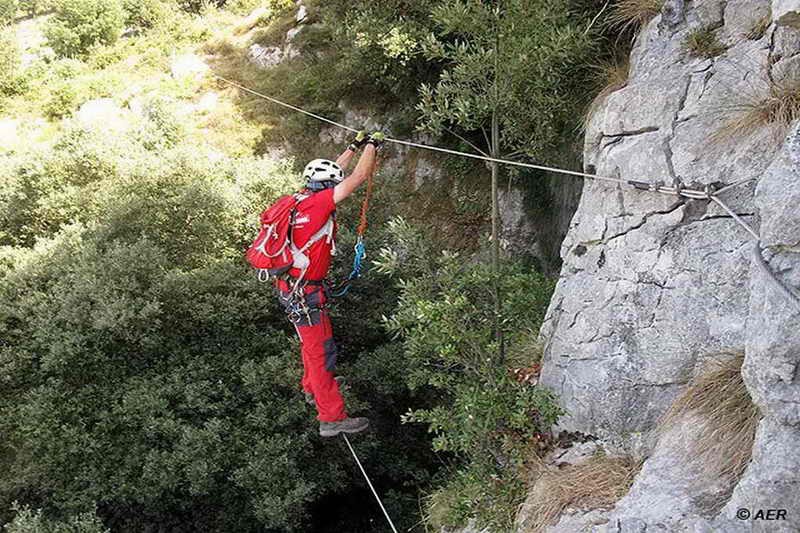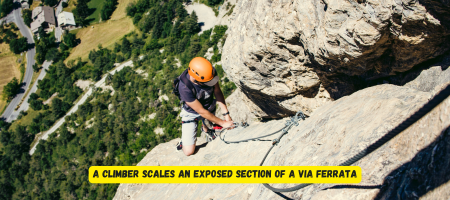Climb to new heights of adventure with the Via Ferrata La Hermida.
Via Ferrata La Hermida, nestled in the breathtaking Hermida Gorge of Cantabria just at the doorstep of Picos de Europa, is a truly spectacular route combining natural beauty, moderate challenge, and historical landscape. Spanning approximately 900 m in length with a vertical gain of 318 m, this via ferrata offers a memorable adventure for families, beginners, and those seeking to enhance their experience with more advanced sections

Location & Access
- Where: On the north face of Peña Agero, just above La Hermida village, alongside the N‑621 road between Panes, Potes, and San Vicente de la Barquera.
- Access: 10–15 minute walk from the reception center at the Balneario de La Hermida, situated at authorised parking. Here you’ll register, rent gear, and obtain route guidance .
- Season: Open March 1–Nov 30; limited winter access .
Click here for a selection of adventures all over Europe.
Difficulty & Route Breakdown
La Hermida is graded K3 overall, with sections spanning from K1–K3—ideal for families and beginners, while still exciting for seasoned climbers.
Its structure comprises three main segments:
- Initiation & Introductory Passages (K1–K2)
Gentle beginnings through wooded ramps and cable-assisted forest trails. Ideal for novices and children to gain confidence . - Cueva Jabalí & Carla Garrido Ramp (K2–K3)
This intermediate section features vertical steps, natural rock use, and moderate exposure. Climbers traverse through Cueva Jabalí and tackle the ramp named for psychologist Carla Garrido—both demanding more effort but still accessible with caution - Bridge Variant
- Climbers may choose the Puentes route, featuring:
- A wooden/tibetan Bridge Diosu (~35 m), requiring extensions for safety due to high cables.
- A second Nepalese rope bridge, adding exposure and nerve-testing swinging action.
- Cooler escape routes available throughout, ideal for opting out without completing the full boundary
Click here for another jaw-dropping Via Ferrata adventure in Spain.
The integral route, which includes Cueva Ciloña, is more technical and less marked—recommended for experienced climbers only, often requiring a guide.

🕒 Duration & Logistics
- Approach: ~15 min to base, via forested and paved trails .
- Ferrata completion: ~1.5 hours climbing time for most travellers .
- Return hike: ~2 hours down a rocky forested path back to the road; can be confusing if hiking alone—grouping up or following GPX tracks is wise .
- Full day trip: Expect a total of 4–5 hours from start to return.

Required Equipment
- Mandatory gear: helmet, harness, via ferrata set (lanyards with energy absorbers); gloves optional.
- Recommended extras: long extension strap (~20–50 cm) for bridges, comfortable hiking shoes/trail runners, weather layers, water and light snacks .
- Rental: Available at reception—complete kit ~€18 for DIY; guided group combos from €40–60 per person.
Safety & Advice
- Register before climbing; gear and route orientation are provided.
- Cables are high on bridges—an extension strap is essential to stay safely clipped in .
- Return path is shown to be tricky—stay on marked trails, use guides or GPS tracks to avoid getting lost .
- Avoid peak season crowds, especially midday in summer—early morning climbs are optimal .
- Escape toward easier trails if the technicality becomes too much.
Click here for an unforgettable adventure spanning four countries.
Why it’s worth it
- Family-friendly head start: You don’t need to be an expert to start—kids and beginners can experience exposure in a safe setting.
- Bridges & exposure: Few via ferratas offer two long, swinging bridges with towering views over the gorge.
- Stunning natural setting: Located within the Saja‑Nansa region and at the edge of Picos de Europa, the scenery is breathtaking.
- Flexible itinerary: Climbers choose how far to go—from kid-friendly basics to full K3 exposure.
- Free and public access: You can climb on your own without mandatory guiding (but equipment rental is available) .
Best Time to Visit
- Open March to November—avoid mid-winter.
- Spring/Autumn: ideal weather, fewer crowds.
- Summer: early morning climbs are best to avoid midday heat.
- Rainy/windy days: avoid ferrata due to rock slipperiness and exposure.
If you want to lose weight before attempting Via Ferratas, click here.
Local Highlights
- La Hermida Gorge & Balneario: Relax in thermal springs after the climb.
- Picos de Europa: Stunning landscapes, wildlife, and hiking opportunities.
- Nearby ferratas: Try El Milar, Stairway to Heaven, and Peñarruscos for further adventure.
- Santillana del Mar & Cabárceno Wildlife Park: Great for post-climb culture and family fun.
- Local gastronomy: Taste regional cheeses, smoked meats, and Cantabrian specialties.
Click here for a selection of stylish, practical and outdoor appropriate menswear.
Final Verdict
Via Ferrata La Hermida is a versatile gem in Northern Spain—a route that welcomes families and novices while offering excitement to seasoned adventurers. With its iconic bridges, lush gorge views, and flexible route options, it blends natural wonder with accessible thrill. The only caveat: bring a good extension strap, arrive early, and stay sharp on the return route. Done right, it offers an unforgettable ascent through one of Spain’s most dramatic settings.
Whether you’re introducing someone to via ferratas or seeking a scenic climb amid dramatic cliffs, La Hermida ranks among the top ferrata experiences in Spain’s north.


